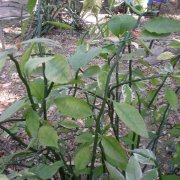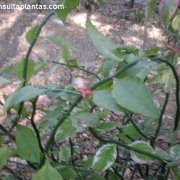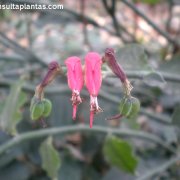Care of the succulent plant Euphorbia tithymaloides or Devil's Backbone |
|
The genus Euphorbia, family Euphorbiaceae, includes some 7,000 species of cactiform succulents, herbaceous plants and shrubs distributed on all continents. Some species are: Euphorbia tithymaloides, Euphorbia viguieri, Euphorbia hypericifolia, Euphorbia piscatoria, Euphorbia meloformis, Euphorbia lambii, Euphorbia piscatoria, Euphorbia regis-jubae, Euphorbia umbellata, Euphorbia pulcherrima, Euphorbia cotinifolia, Euphorbia milii, Euphorbia characias, Euphorbia dendroides, Euphorbia rigida, Euphorbia leucocephala, Euphorbia anachoreta. Common names: Devil's Backbone, Foot Plant, Ribbon Cactus, Christmas Candle, Aperejo, Myrtle-leaved Foot-plant, Tuturutu, Pinipini, Zig-Zag Plant, Slipper Spurge, Slipper Plant, Slipper Flower, Redbird Flower, Redbird Cactus, Red Slipper Spurge, Padus-Leaved Clipper Plant, Myrtle-Leaved Spurge, Milk-Hedge, Jewbush, Jew's Slipper, Japanese Poinsettia, Jacob's Ladder, Fiddle Flower, Buck-thorn. Scientific synonym: Pedilanthus tithymaloides. This species is native to tropical regions of the American continent. They are bushy succulent plants that reach 3 meters (9.84 feet) in height. The fleshy green stalks grow in a zigzag pattern. The alternate, oval leaves are green with white, pink or reddish spots. The small flowers are wrapped in showy red bracts. They bloom in summer but do not usually bloom indoors. Devil's Backbone is used as indoor and greenhouse plants. In tropical and subtropical regions it's used as isolated specimens and in shrub groups. Euphorbia tithymaloides prefers a semi-shade exposure avoiding direct sun during the hottest hours of the day. It does not resist temperatures below 13 ºC (55.4 ºF). The soil can be normal, well-drained garden soil with coarse sand and containing abundant organic matter. Water regularly from spring to fall waiting for the substrate to dry. Water occasionally in winter. If the summer is very hot, the leaves should be sprayed periodically with lime-free water. Fertilize with a little compost or manure in early spring. Zig-Zag Plant does not usually need pruning; If you prune a branch, be careful with the irritating latex they produce. Euphorbia tithymaloides can be attacked by Powdery mildew in winter if the humidity is too high. Foot Plant is propagated by cuttings in spring, summer or fall; clean the irritating latex with a damp cloth and plant in a slightly damp sandy substrate at 20-22 ºC (68-71 ºF). |
Images of the succulent plant Euphorbia tithymaloides or Devil's Backbone |
Find plants
Euphorbia tithymaloides or Devil's Backbone | Care and Growing
© 2026 FavThemes


